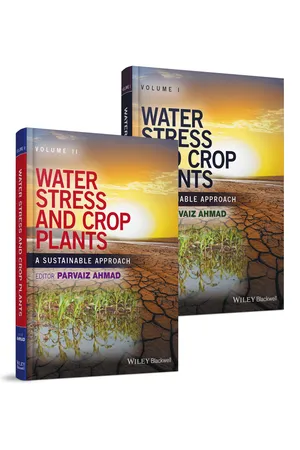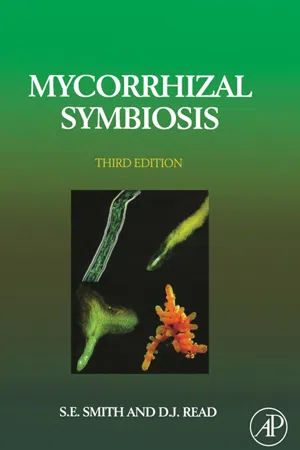Biological Sciences
Ectomycorrhizae
Ectomycorrhizae is a symbiotic relationship between certain fungi and the roots of plants, particularly trees. The fungi form a sheath around the plant roots, enhancing the plant's ability to absorb nutrients from the soil. In return, the plant provides the fungi with carbohydrates. This mutually beneficial relationship is important for the health and growth of many tree species.
Written by Perlego with AI-assistance
Related key terms
3 Key excerpts on "Ectomycorrhizae"
- eBook - ePub
Water Stress and Crop Plants
A Sustainable Approach
- Parvaiz Ahmad(Author)
- 2016(Publication Date)
- Wiley-Blackwell(Publisher)
For many years, mycorrhizal fungi have been speculated to be parasitic and pathogenic. Their nomenclature as “Rhizophagus,” meaning “root eater” (Dangeard, 1900), reflects the same. Rayner (1926), however, admitted that Ectomycorrhiza could be beneficial to the host plant, but the same could not be said about the Arbuscular Mycorrhiza. As the time elapsed, the mutualistic association of mycorrhiza was realized. Accumulated research revealed that plants associated with mycorrhiza are furnished with faster growth compared to non-mycorrhizal plants. Similarly, the older perception of “infection”, which was associated with the disease causing ability of mycorrhiza, was replaced with a more accurate term, “colonization.” The impressive biodiversity of plant fungal symbiosis has been the result of extensive colonization of fungal hyphae in the roots of plants. The presymbiotic structures that develop into hyphae, independent of plant support, assist fungi in their survival, completion of life cycles, and mobilization of nutrients (Koide and Mosse, 2004). Upon developing into the symbiotic form, hyphae facilitate fungal interaction with host plants through diverse colonization patterns reflected in various classes of mycorrhizal fungi.Among a series of confounding functions of mycorrhizal association, mitigation of drought stress in plant remains a major milestone (Abbaspour et al., 2012; Li et al., 2013). Maintaining water potential in plants and promoting their growth during water deficit conditions remains an important task for the mycorrhizal association (Smith and Read, 2008; Grumberg et al., 2015). Fungal hyphae invaginate the complex plant root, the enlarged surface area facilitates increased water absorption, despite low soil water potential (Ruiz-Lozano et al - eBook - ePub
- Darlene Southworth(Author)
- 2011(Publication Date)
- Wiley-Blackwell(Publisher)
We thank colleagues at INRA-Nancy, France for their input and collaboration, specifically Annegret Kohler, Marc Buée, Pascale Frey-Klett, Stephan Uroz, Valérie Legué, Francois LeTacon, Claude Murat and Judith Felten whose contributions made this work possible. This research was sponsored by the Genomic Science Program, U.S. Department of Energy, Office of Science, Biological and Environmental Research, contract DE-AC05-00OR22725 (PMI SFA Oak Ridge National Laboratory).REFERENCESAdams F, Reddell P, Webb MJ, et al. (2006) Arbuscular mycorrhizas and ectomycorrhizas on Eucalyptus grandis (Myrtaceae) trees and seedlings in native forests of tropical north-eastern Australia. Australian Journal of Botany 54:271–281.Agerer R (1993) Color Atlas of Ectomycorrhizae , 7th ed. Einhorn, Schwäbisch Gmünd.Albrecht C, Asselin A, Piché Y, et al. (1994) Chitinase activities are induced in Eucalyptus globulus roots by ectomycorrhizal or pathogenic fungi, during early colonization. Physiologia Plantarum 91:104–110.Alexander T, Toth R, Meier R, et al. (1989) Dynamics of arbuscule development and degeneration in onion, bean and tomato with reference to vesicular-arbuscular mycorrhiza with grasses. Canadian Journal of Botany 67:2505–2513.Barea JM, Pozo MJ, et al. (2005) Microbial co-operation in the rhizosphere. Journal of Experimental Botany 56:1761–1778.Béguiristain T, Côté R, Rubini P, et al. (1995) Hypaphorine accumulation in hyphae of the ectomycorrhizal fungus, Pisolithus tinctorius . Phytochemistry 40:1089–1091.Béguiristain T, Lapeyrie F (1997) Host plant stimulates hypaphorine accumulation in Pisolithus tinctorius hyphae during ectomycorrhizal infection while excreted fungal hypaphorine controls root hair development. New Phytologist 136:525–532.Bevege DI, Bowen GD, Skinner MF (1975) Comparative carbohydrate physiology of ecto- and endomycorrhizas. In: Endomycorrhizas - eBook - ePub
- Sally E. Smith, David J. Read(Authors)
- 2010(Publication Date)
- Academic Press(Publisher)
Alexander and Lee, 2005 ).A defining feature of tropical rainforest is the enormous diversity of plant species in the communities. In the tree flora alone, Wright (2002) recorded 1175 species in a 0.52 km2 plot of Borneo rainforest. This is more than occur in all of the boreo-temperate forests of the northern hemisphere. Within this diversity it is possible to recognize some patterns with respect to the distribution of mycorrhizal types. While most rainforest tree species associate with AM fungi, there are families of tropical plants which are predominantly or entirely ectomycorrhizal (Alexander, 1989a ). These include the Dipterocarpaceae (Lee et al. , 1996), Fagaceae (Comer, 1972 ), many legumes in the Caesalpinoideae (Alexander, 1989b ) and members of the subfamily Leptospermoideae in the Myrtaceae (Moyersoen et al. , 2001). Circumstantial evidence suggests that there is a relationship between mycorrhizal type and soil conditions. Whereas trees with AM colonization predominate over large areas of such systems, there are localized occurrences in South American (Singer and Araujo, 1979 , 1986; Henkel, 2003 ), West African (Newbery et al. , 1988) and South-East Asian (Whitmore, 1984 ) forests of communities dominated by ECM species. Although these are often restricted to the most nutrient-poor soils with a surface accumulation of litter and raw humus (Torti et al. , 2001; Henkel, 2003 ), deductions concerning possible ecological relationships between mycorrhizal and soil types must be drawn with caution in view of the background phylogenetic histories of each family. This complication is best illustrated by the generally ectomycorrhizal Dipterocarpaceae which dominate the rainforests of South-East Asia almost irrespective of soil type (Whitmore, 1984 ), and apparently without particular association with nitrogen-limiting conditions (Alexander and Lee, 2005
Learn about this page
Index pages curate the most relevant extracts from our library of academic textbooks. They’ve been created using an in-house natural language model (NLM), each adding context and meaning to key research topics.


